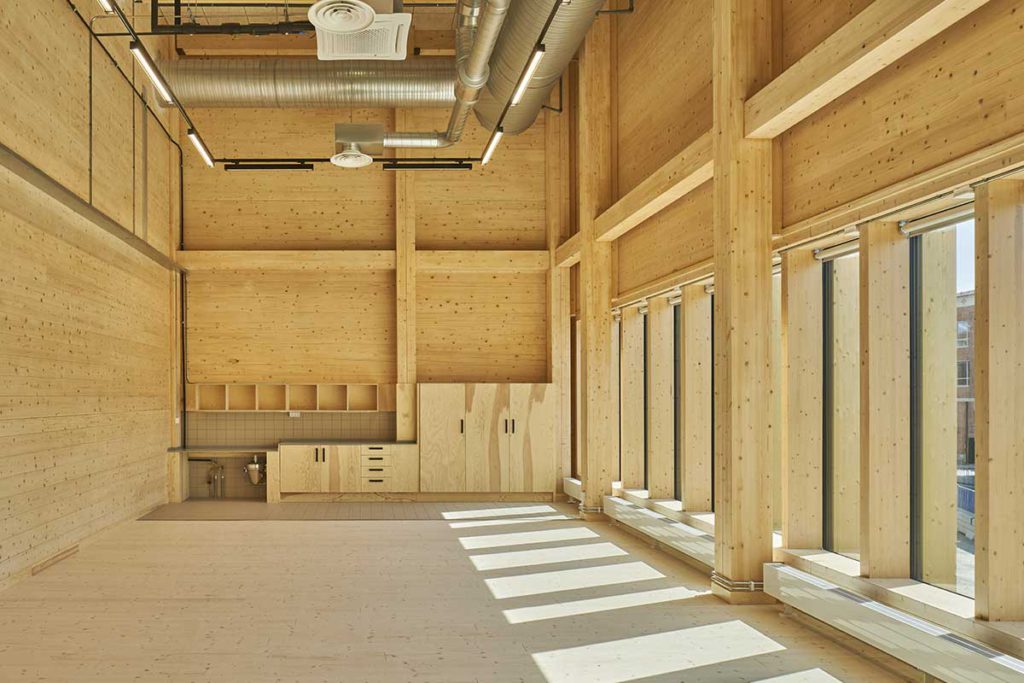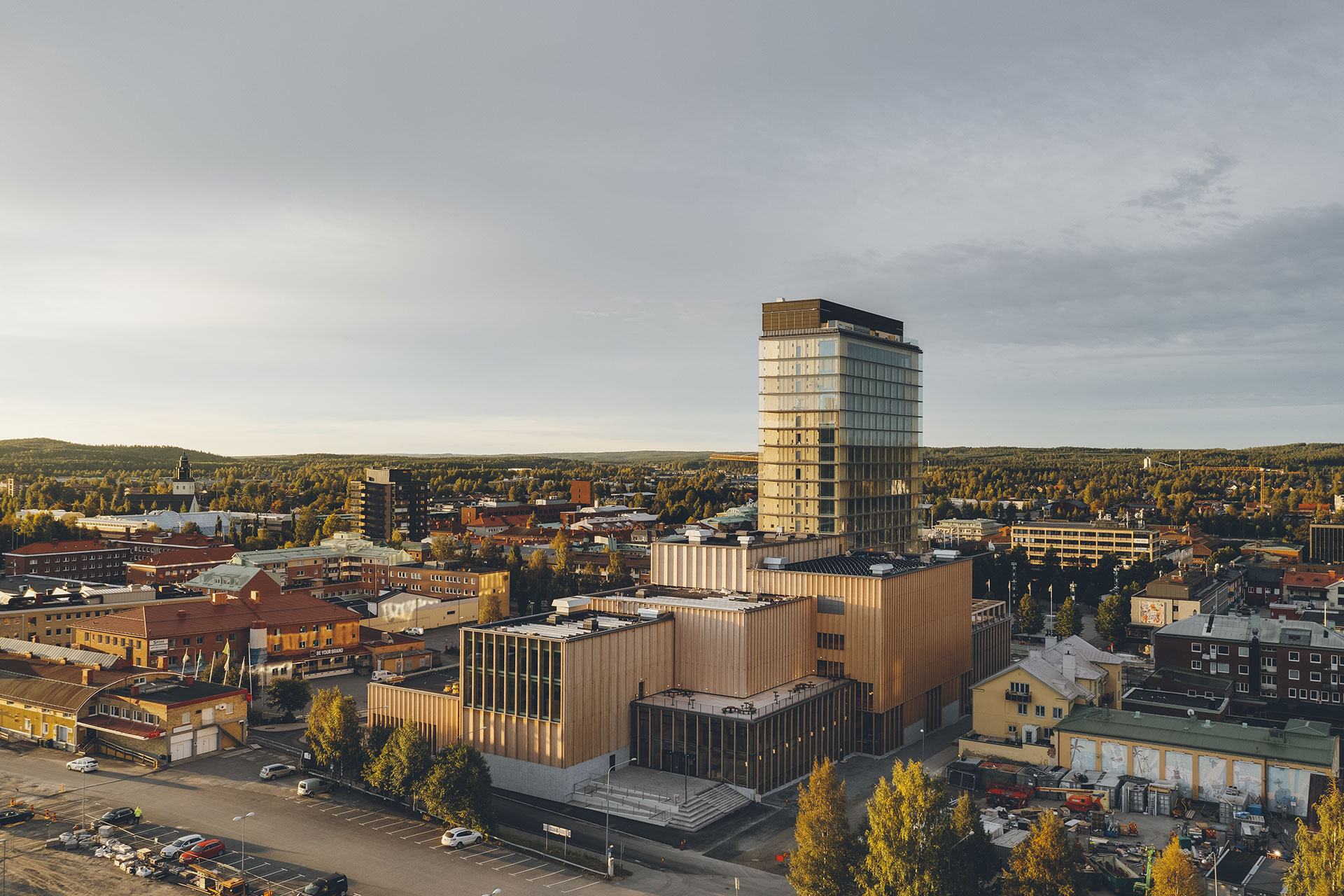Sara Kulturhus in Skellefteå, Sweden made of locally sourced Cross-laminated timber and Glue-laminated timber: from locking CO2 to reducing building times and costs
Seventy-five meters tall, the Sara Kulturhus is the second tallest wooden building in the world, after Mjøstårnet in Norway. Built in the relatively small town of Skellefteå in Sweden, it has become a symbol both for the town and for architects interested in the use of new wooden materials. The building hosts a cultural center and a hotel with spaces for arts, performance and literature. The noticeable aspects of Sara Kulturhus, however, go far beyond its height.
Lampoon reports: Sara Kulturhus
«It all began in 2015 as an architecture competition», explains architect Oskar Norelius of Swedish studio, White Arkitekter. The municipality of Skellefteå launched an open call to design a hotel and culture house in the city center. At the same time, the administration was working on strategies to attract more people», not just as tourists but as residents too: «People were moving from smaller or more rural areas to big cities, a tendency towards urbanization that you can see almost everywhere in the world today».
Skellefteå wanted to change this. Citizens tend to move because they find better job opportunities in larger urban conglomerates, but it’s not just about that: capitals and bigger cities are generally more likely to offer a vibrant cultural and art scene.
Talking to the people, the municipality understood that in order to make the city a more attractive place to be, there were two main aspects that were to be implemented: creating more jobs, especially in emerging industries and improving the cultural life of the city. As Norelius explains: «Cultural associations were already there» but they were lacking attractive infrastructure.
Simultaneously, White Arkitekter was exploring timber as a new possible structural material: «We had worked with it in smaller buildings like visitor centers and multi-storey residential, so we decided in our research lab if we could do this competition all in timber, or using as much timber as possible».
Putting this amount of effort into research of this kind was possible at White Arkitekter mainly because we are used to it and have been for a long time: «We include environmental specialists in our teams since early in the Nineties».
Building: a combination of CLT and GLT
The whole structure was built by using a combination of two engineered woods: CLT and GLT. They stand for Cross-laminated timber and Glue-laminated timber: «GLT has been around much longer than CLT, and it’s what you use to make columns and beams».
GLT is made of pieces of timber glued together with all the fibers positioned in the same direction: «It’s a way to create a timber that is more homogenous and since it’s made of many pieces you can be quite shore of its performance» as opposed to using just plain timber: «Trees in the forest are all different but pieces of GLT are all the same».
In Sara Kulturhus, GLT was used to carry vertical load and to span lengths to free up open spaces. CLT is also made of pieces of wood glued together, but instead of being all placed in the same direction, they are crossed «which means the material becomes very stiff and can be used partially to carry load, in form of walls, but also and mainly to take the sheer load» when there are strong winds outside or when the building has to endure movement.
CLT transfers that weight down to the foundations and allows the building to resist forces. The two materials were applied according to these functionalities in Sara Kulturhus. «Apart from structural purposes, CLT was also used for internal walls which are low-bearing».

Locally sourced wood
All the wood was sourced locally thanks to the prolific wood industry of the region, which has a longstanding tradition: «The advancement of research in engineered timber has unleashed a world of previously unimagined design possibilities». At the same time, the project shows how it has become possible to use wood as a material to build structural elements – which was almost unthinkable until recently.
Though restoring buildings that are already there remains the most sustainable way for the construction industry, using engineered wood represents a valuable alternative where it is necessary to build new. Not only do wooden buildings have much lower embedded carbon levels, but they also practically store CO2.
In places like Skellefteå, using wood also means contributing to the local economy and creating new jobs. Additionally, contrary to what happens by using traditional materials like concrete, you use a resource that is naturally replaced by forests.
Other than timber, the main materials used for Sara Kulturhus, in lower concentration, were glass and steel, which were sourced from abroad for the most part. In terms of costs, it seems complex to draw a comparison between Sara Kultuhus and a similar building made in traditional materials – such as concrete and steel: «You can’t really compare those two», explains architect Robert Schmitz, «because there are so many different aspects».
What changes is the very conception of approaching architecture and building. For instance, in the construction of Sara Kulturhus, «by building in CLT, we have reduced the construction times by more than one year» which means reducing costs considerably: «Taking into account similar culture centers built in Europe around the same time, we are a bit less expensive». When using CLT and GLT, less material is also needed: «We left the material itself exposed, we don’t have to have any dry walls for example».
The advantages of building with Timber
Building with engineered timber, especially where local production and manufacture is available, helps to save time and material, thus reducing costs. It is also less harmful for the environment given that, contrary to traditional materials such as steel or concrete, «wood is a resource that naturally regenerates».
At the same time, wooden constructions have the power to store CO2 as a way of offsetting emissions. Even though the most sustainable way to build undoubtedly remains reusing what is already there and avoiding building new, in those cases where new constructions are needed, wood represents a very practical and convenient solution. It has to become more widespread.
More issues may come up during the practice and they will «vary from country to country». In Sweden, thanks to a performance-based system, you can build as tall as you like in timber, as long as the construction is proved to be safe. This is not the case in most European countries, where legislation on the use of timber remains strict: «This is mainly because no one ever thought it would be possible to build this high in timber, so the legislation mirrors what used to be possible».
For instance, in the United Kingdom, after the Grenfell Tower fire, policies have been made even less permissive than it used to be. Other countries, however, are moving in the opposite direction – The United States and Canada, for one, are implementing new codes that take into account the most recent developments in the field of engineered timber. The key is to thus «push forward» in different ways, in different regions. Sara Kulturhus wants to be a symbol in this fight to push the boundaries of what is possible.
Architecture and carbon neutrality
White Arckitekter is all about pushing forward, even when solutions are not necessarily already available. They claim their architecture will be carbon-neutral by 2030, «but the impact of our work will be neutral even before then». A plan was designed to get there: «We made a roadmap on how the industry can change by 2030».
But it is not just about White. In order to achieve real neutrality, the whole industry has to participate. «The first step for reaching that goal», claims Norelius, «is saying that you have the goal».
The path is not entirely clear yet, «no one can say they know how to become neutral by 2030, but you have to have an ambition, a vision, and work towards it».



















